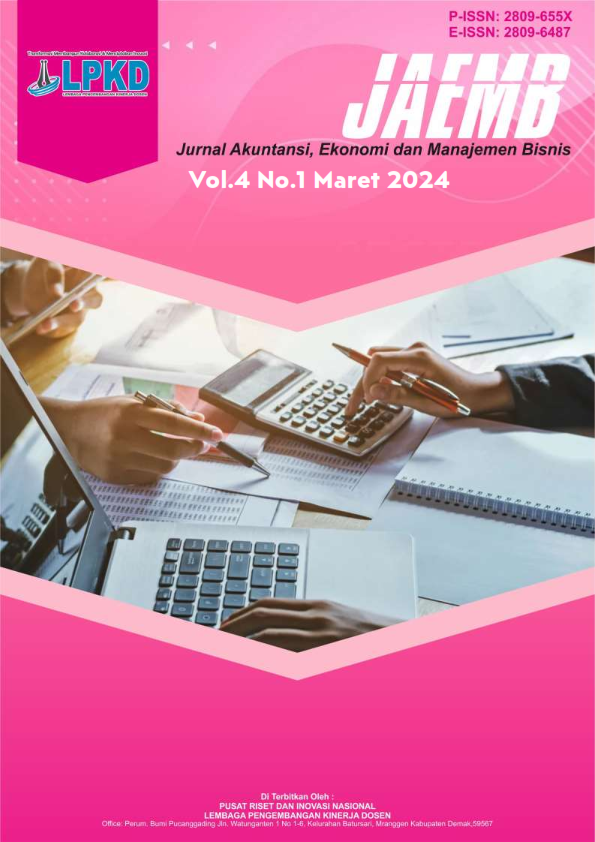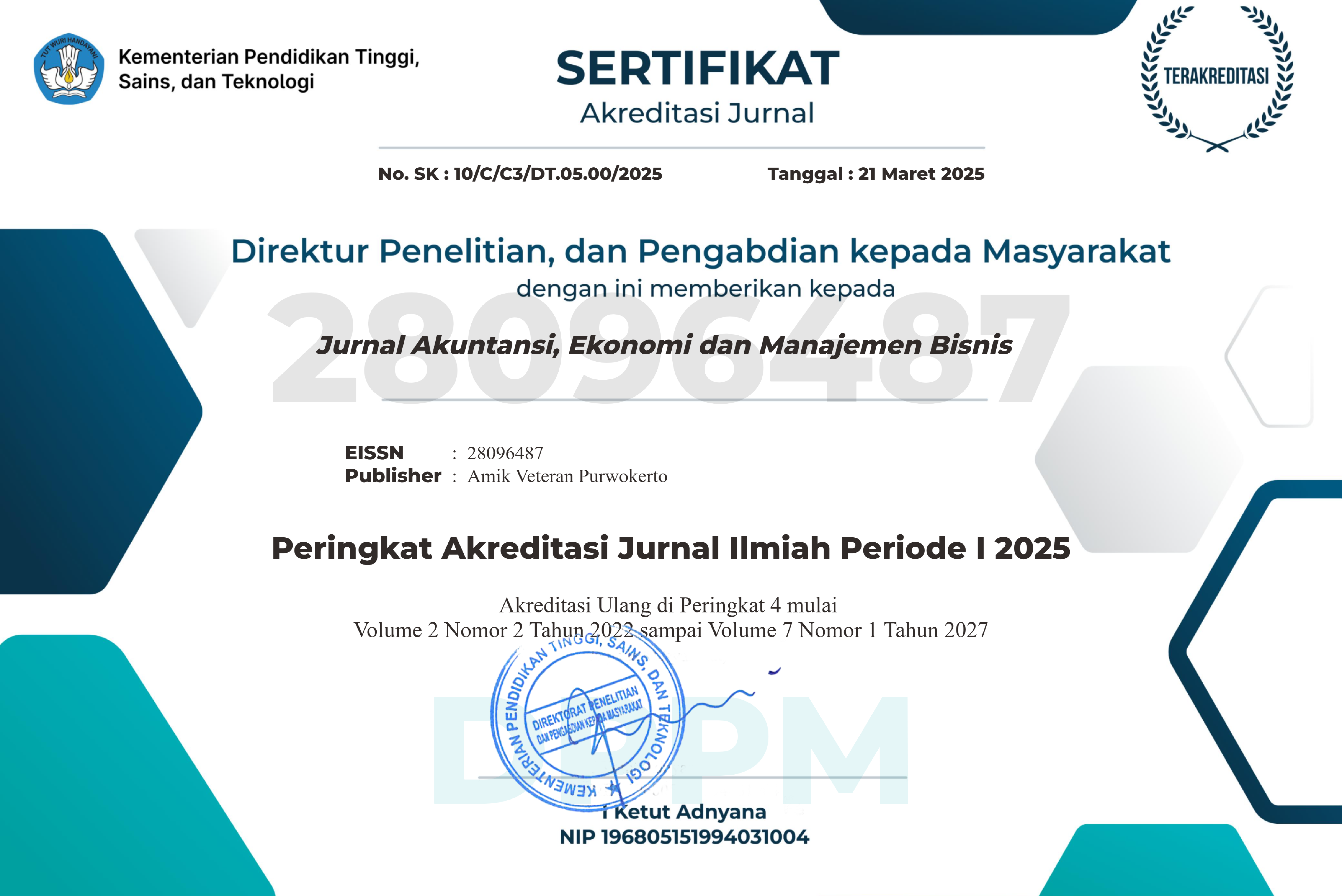THE EFFECT OF ARGUMENT QUALITY AND SOURCE CREDIBILITY ON PURCHASE INTENTION WITH CONSUMER-WELL BEING AS A MEDIATING VARIABLE
DOI:
https://doi.org/10.55606/jaemb.v5i1.5978Keywords:
Argument Quality, Source Credibility, Costumer Well Being and Purchase IntentionAbstract
This study aims to analyze the effect of Argument Quality and Source Credibility on Purchase Intention with Consumer Well-Being as a mediating variable on TikTok users in Indonesia. The phenomenon of the increasing use of influencers in promoting products through TikTok Shop encourages the importance of argument quality and source credibility in influencing consumer purchasing decisions. This study uses a quantitative approach with the PLS-SEM method and involves 150 respondents who are active TikTok users and have purchased skincare products after watching promotional content from influencers Reizuka Ari and Maharaja SP. The results of the study show that Argument Quality has a positive and significant effect on Purchase Intention and Consumer Well-Being. Meanwhile, Source Credibility actually has a negative but significant effect on both variables. In addition, Consumer Well-Being is proven to have a positive and significant effect on Purchase Intention. In terms of mediation, Consumer Well-Being significantly and positively mediates the relationship between Argument Quality and Purchase Intention, but is unable to positively strengthen the relationship between Source Credibility and Purchase Intention
References
[1] N. Adams, T. D. Little, and R. M. Ryan, "Self-determination theory," in Development of Self-Determination Through the Life-Course, Springer Science+Business Media B.V., 2017, pp. 47–54, doi: 10.1007/978-94-024-1042-6_4.
[2] A. T. Asyari and H. S. I. D. Mulyana, Faktor Pendukung Kesuksesan Akademik Mahasiswa Unit, 2018.
[3] Baskurt and Kampman, 2022. [Online]. Available: [Link tidak tersedia – informasi tidak lengkap].
[4] J. Castellanos, P. A. Haya, and J. Urquiza-Fuentes, "A Novel Group Engagement Score for Virtual Learning Environments," IEEE Trans. Learn. Technol., vol. 10, no. 3, pp. 306–317, 2017, doi: 10.1109/TLT.2016.2582164.
[5] P. C. Chang, H. Rui, and A. Y. P. Lee, "How Having a Calling Leads to Job Crafting: A Moderated Mediation Model," Front. Psychol., vol. 11, 2020, doi: 10.3389/fpsyg.2020.552828.
[6] J. Chen and X. Zhang, "The impact of career calling on higher vocational nursing students’ learning engagement: The mediating roles of career adaptability and career commitment," Front. Psychol., vol. 14, 2023, doi: 10.3389/fpsyg.2023.1111842.
[7] X. Chen and T. Wang, "A Study of Learning Engagement and Its Influencing Factors Under E-Learning Platform: Based on Behavioral Event Analysis Model," pp. 428–433, 2023, doi: 10.2991/978-94-6463-040-4_65.
[8] R. D. Duffy and W. E. Sedlacek, "The Salience of a Career Calling Among College Students: Exploring Group Differences and Links to Religiousness, Life Meaning, and Life Satisfaction," J. Career Assess., vol. 18, no. 4, pp. 420–430, 2010.
[9] B. J. Dik and R. D. Duffy, "Calling and Vocation at Work: Definitions and Prospects for Research and Practice," The Counseling Psychologist, vol. 37, no. 3, pp. 424–450, 2009, doi: 10.1177/0011000008316430.
[10] B. J. Dik, B. M. Eldridge, M. F. Steger, and R. D. Duffy, "Development and Validation of the Calling and Vocation Questionnaire (CVQ) and Brief Calling Scale (BCS)," J. Career Assess., vol. 20, no. 3, pp. 242–263, 2012, doi: 10.1177/1069072711434410.
[11] S. R. Dobrow et al., "Calling: The Development of a Scale Measure," [Manuscript]. [Online]. Available: [Link tidak tersedia].
[12] R. P. Douglass and R. D. Duffy, "Calling and career adaptability among undergraduate students," J. Vocational Behavior, vol. 86, pp. 58–65, 2015, doi: 10.1016/j.jvb.2014.11.003.
[13] R. D. Duffy, "Sense of Control and Career Adaptability Among Undergraduate Students," J. Career Assess., vol. 18, no. 4, pp. 420–430, 2010, doi: 10.1177/1069072710374587.
[14] R. D. Duffy, B. A. Allan, and E. M. Bott, "Calling and Life Satisfaction Among Undergraduate Students: Investigating Mediators and Moderators," J. Happiness Stud., vol. 13, no. 3, pp. 469–479, 2012, doi: 10.1007/s10902-011-9274-6.
[15] R. D. Duffy, B. A. Allan, and B. J. Dik, "The presence of a calling and academic satisfaction: Examining potential mediators," J. Vocational Behavior, vol. 79, no. 1, pp. 74–80, 2011, doi: 10.1016/j.jvb.2010.11.001.
[16] A. R. Elangovan, C. C. Pinder, and M. McLean, "Callings and organizational behavior," J. Vocational Behavior, vol. 76, no. 3, pp. 428–440, 2010, doi: 10.1016/j.jvb.2009.10.009.
[17] J. A. Fredricks, P. C. Blumenfeld, and A. H. Paris, "School Engagement: Potential of the Concept, State of the Evidence," Rev. Educ. Res., vol. 74, no. 1, 2004.
[18] D. T. Hall and D. E. Chandler, "Psychological success: When the career is a calling," J. Organ. Behav., vol. 26, no. 2, pp. 155–176, 2005, doi: 10.1002/job.301.
[19] A. Hirschi, "Calling and Career Preparation," 2013.
[20] A. Hirschi, "Callings in career: A typological approach to essential and optional components," J. Vocational Behavior, vol. 79, no. 1, pp. 60–73, 2011, doi: 10.1016/j.jvb.2010.11.002.
[21] W. Huang and S. Zhang, "The impact of meaning in life on preservice teachers’ innovative behavior: the chain mediating effects of career calling and learning engagement," Current Psychol., vol. 43, no. 20, pp. 18294–18306, 2024, doi: 10.1007/s12144-024-05671-9.
[22] X. Huang et al., "Career Calling as the Mediator and Moderator of Job Demands and Job Resources for Job Satisfaction in Health Workers: A Cross-Sectional Study," Front. Psychol., vol. 13, 2022, doi: 10.3389/fpsyg.2022.856997.
[23] I. Hunter, B. J. Dik, and J. H. Banning, "College students’ perceptions of calling in work and life: A qualitative analysis," J. Vocational Behavior, vol. 76, no. 2, pp. 178–186, 2010, doi: 10.1016/j.jvb.2009.10.008.
[24] L. H. S. Jaya and E. Ariyanto, "The Effect of Vigor, Dedication and Absorption on the Employee Performance of PT Garuda Indonesia Cargo," Eur. J. Business and Management Research, vol. 6, no. 4, pp. 311–316, 2021, doi: 10.24018/ejbmr.2021.6.4.1006.
[25] X. Jian, T. T. Wijaya, and Q. Yu, "Key Factors Affecting Mathematics Teachers’ Well-Being and Stress Levels: An Extended Engagement Theory," Int. J. Environ. Res. Public Health, vol. 20, no. 1, 2023, doi: 10.3390/ijerph20010548.
[26] Y. Jung and J. Lee, "Learning Engagement and Persistence in Massive Open Online Courses (MOOCs)," Computers and Education, vol. 122, pp. 9–22, 2018, doi: 10.1016/j.compedu.2018.02.013.
[27] F. Li, R. Jiao, D. Liu, and H. Yin, "The Search for and Presence of Calling: Latent Profiles and Relationships With Work Meaning and Job Satisfaction," Front. Psychol., vol. 12, 2021, doi: 10.3389/fpsyg.2021.633351.
[28] R. A. Listiyandini, "Peranan Optimisme terhadap Resiliensi pada Mahasiswa Tingkat Akhir yang Mengerjakan Skripsi," 2016. [Online]. Available: https://www.researchgate.net/publication/318128262
[29] X. Liu, X. Ji, Y. Zhang, and W. Gao, "Professional Identity and Career Adaptability among Chinese Engineering Students: The Mediating Role of Learning Engagement," Behavioral Sciences, vol. 13, no. 6, 2023, doi: 10.3390/bs13060480.
[30] N. N. Oktovani and M. Riasnugrahani, "Search for Calling, Presence for Calling dan Makna Kerja Pada Karyawan Kehutanan," Aksara: Jurnal Ilmu Pendidikan Nonformal, vol. 8, no. 2, pp. 1429–1438, 2022, doi: 10.37905/aksara.8.2.1429-1438.2022.
[31] Í. M. Oliveira and C. Marques, "The Role of Career Adaptability and Academic Engagement in College Student’s Life Satisfaction," Int. J. Environ. Res. Public Health, vol. 21, no. 5, 2024, doi: 10.3390/ijerph21050596.
[32] M. Parmentier, T. Pirsoul, and F. Nils, "Examining the impact of emotional intelligence on career adaptability: A two-wave cross-lagged study," Personality and Individual Differences, vol. 151, 2019, doi: 10.1016/j.paid.2019.05.052.
[33] J. Peng et al., "Career Calling and Job Satisfaction in Army Officers: A Multiple Mediating Model Analysis," Psychol. Reports, vol. 123, no. 6, pp. 2459–2478, 2020, doi: 10.1177/0033294119862990.
[34] A. Praskova, P. A. Creed, and M. Hood, "The Development and Initial Validation of a Career Calling Scale for Emerging Adults," J. Career Assess., vol. 23, no. 1, pp. 91–106, 2015, doi: 10.1177/1069072714523089.
[35] J. Reeve and C. M. Tseng, "Agency as a fourth aspect of students’ engagement during learning activities," Contemp. Educ. Psychol., vol. 36, no. 4, pp. 257–267, 2011, doi: 10.1016/j.cedpsych.2011.05.002.
[36] A. Rothes, M. S. Lemos, and T. Gonçalves, "The Influence of Students’ Self-Determination and Personal Achievement Goals in Learning and Engagement: A Mediation Model for Traditional and Nontraditional Students," Education Sciences, vol. 12, no. 6, 2022, doi: 10.3390/educsci12060369.
[37] R. M. Ryan and E. L. Deci, "Brick by Brick: The Origins, Development, and Future of Self-Determination Theory," [Online]. [n.d.].
[38] R. M. Ryan and E. L. Deci, "Self-Determination Theory and the Facilitation of Intrinsic Motivation, Social Development, and Well-Being," 1985.
[39] M. L. Savickas and E. J. Porfeli, "Career Adapt-Abilities Scale: Construction, reliability, and measurement equivalence across 13 countries," J. Vocational Behavior, vol. 80, no. 3, pp. 661–673, 2012a, doi: 10.1016/j.jvb.2012.01.011.
[40] M. L. Savickas and E. J. Porfeli, "Career Adapt-Abilities Scale: Construction, reliability, and measurement equivalence across 13 countries," J. Vocational Behavior, vol. 80, no. 3, pp. 661–673, 2012b, doi: 10.1016/j.jvb.2012.01.011.
[41] W. Shang, T. Yu, X. Liang, J. Wang, and J. Su, "How Does Career Calling Influence Preservice Teachers’ Learning Engagement? A Multiple Mediating Roles of Occupational Self-Efficacy and Vocational Outcome Expectation," Front. Psychol., vol. 13, 2022, doi: 10.3389/fpsyg.2022.874895.
[42] K. Strauss, M. A. Griffin, and S. K. Parker, "Future work selves: How salient hoped-for identities motivate proactive career behaviors," J. Applied Psychol., [vol./issue missing – data incomplete].
[43] M. Shafiq, S. Iqbal, and A. Khan, "Factors influencing consumer purchase intention: A case study of brand loyalty," J. Business Research, vol. 25, no. 3, pp. 98–107, 2011.
[44] A. Sincia, I. G. Putra, and M. Pratama, "The impact of source credibility on consumer behavior: Trustworthiness and its effects on purchasing decisions," J. Ekonomi dan Pemasaran, vol. 22, no. 4, pp. 199–211, 2021.
[45] Sugiyono, Metode Penelitian Kuantitatif, Kualitatif, dan R&D, 6th ed., Alfabeta, 2012.
[46] Suharyadi and Purwanto, Metode Penelitian dan Analisis Data dengan Menggunakan SPSS, 1st ed., Andi, 2016.
[47] S. S. Teng, X. Zhang, and Y. Liu, "Information obtained from high-quality arguments can convince consumers of the benefits of a product and increase their desire to make a purchase," J. Marketing Research, vol. 45, no. 3, pp. 453–466, 2014.
[48] S. Waluyo, "Minat beli konsumen dan faktor-faktor yang mempengaruhinya," J. Ekonomi dan Pemasaran, vol. 15, no. 2, pp. 103–115, 2022.
[49] A. Widyaningrum and M. Isa, "The influence of argument quality and influencer credibility on purchase intention of skincare products with consumer well-being as a mediating variable on the TikTok platform," J. Digital Marketing, vol. 18, no. 3, pp. 150–165, 2023.
[50] A. Widyaningrum, M. Isa, and U. M. Surakarta, "The influence of argument quality and influencer consumer well-being as a mediating variable on the TikTok," vol. 7, pp. 7508–7525, 2024.
[51] A. Yulianti and A. Keni, "The impact of high-quality arguments and influencer credibility on consumer purchase intention," J. Marketing and Consumer Behavior, vol. 10, no. 2, pp. 134–146, 2022.
[52] I. Yulianti and R. Keni, "Kredibilitas komunikasi dalam pemasaran: Pengaruh pengetahuan dan pengalaman terhadap keputusan konsumen," J. Manajemen Pemasaran, vol. 14, no. 1, pp. 73–85, 2022.
Downloads
Published
How to Cite
Issue
Section
License
Copyright (c) 2025 Jurnal Akuntansi, Ekonomi dan Manajemen Bisnis

This work is licensed under a Creative Commons Attribution-ShareAlike 4.0 International License.








